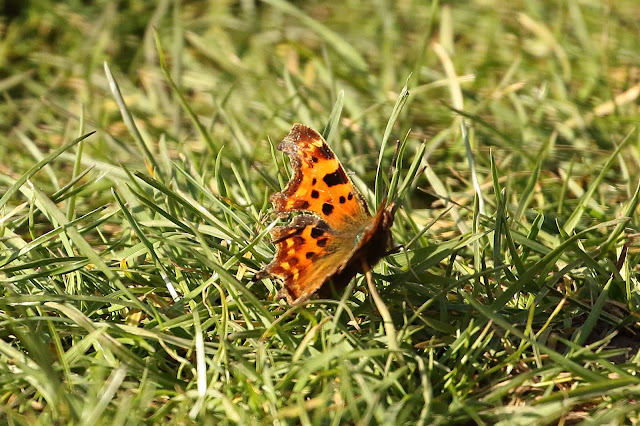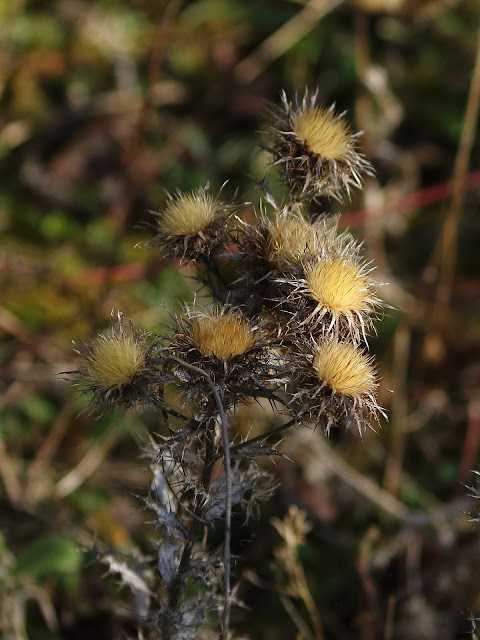Sightings and news for the Naturewatch group of Great and Little Abington in Cambridgeshire, UK. See below for more details and information on how to join.
Monday, 30 March 2020
Pond visitors
Sunday, 29 March 2020
Old Railway Cutting walk
The Blackcap were singing from deep inside the scrub today, due cold to the wind, but the Chiffchaff and Robin were in full view. Far away a Corn Bunting was also singing, and several Hare were busy chasing each other around the field. A few flowers were also starting to appear.
News. First Willow Warbler heard
Whilst taking some exercise along the Old Railway Cutting yesterday, David F reported hearing the first Willow Warbler of the season - some four weeks earlier than the first report last year!
Visually similar to the Chiffchaff, the Willow Warbler is readily distinguished by its soft somewhat whistling song ending with a phrase of descending notes.
Click below (then click u) to listen to the song
Willow Warbler
Thursday, 26 March 2020
Blue Tit 'spring clean'
Meanwhile, in the large tree nearby where the House Sparrows have a colony, one male House Sparrow was basking in the sun
Tuesday, 24 March 2020
Sunny weather brings out the butterflies
Please feel free to email your butterfly sightings to Jennifer at jennifer@hirsh.com.
News. First Bee-fly spotted
Derek T reported a Beefly in his front garden on Cambridge Road today (23rd).
Jennifer commented this was first sighting of a Beefly this year in the Abingtons, slightly earlier than previous years, the first sightings being on 24th March in 2019 and 2017, and on 5th April in 2018.
Since this first report, Derek has seen two more Beefly is his garden, and Andy M saw one near the Old Railway Cutting and two in his garden - all in sunny spots (24th).
Looking like a bee, Beefly have yellowy-brown hair on the body, long, spindly legs, and a long, straight proboscis that it uses to feed on nectar from spring flowers, such as primroses and violets. Beeflies are on the wing in the early spring, when they can often be seen in sunny patches. In flight, they are even more like a bee as they produce a high-pitched buzz. There are several species of beefly in the UK, which can be difficult to tell apart; the Dark-edged Bee-fly has a dark edge to the wing, while others have plainer, translucent wings. [source Wildlife Trust website]
Monday, 23 March 2020
Garden Birds
Blackbird on the nest
Sunday, 22 March 2020
Old Railway Cutting walk
Between the footpath and the Hildersham parish boundary, there appeared to be three singing male Chiffchaff and two male Blackcap, each staking out a territory and hoping to attract a mate.
Several Skylark were seen and heard singing whilst hovering high above the fields, and down below a Magpie was spotted collecting nesting materials.
The Blackthorn was starting to flower well, and old Thistle heads seemed to shine in the early morning light.
News: Blackcap singing - first this year
Less than a week after the first Chiffchaff were heard singing their characteristic song, Andy M heard the first Blackcap singing this morning, along the Old Railway Cutting.
Last year in the Abingtons, the first singing Blackcap was heard on 19th March, also along the Old Railway Cutting - remarkably consistent timing!
Producing a fine musical song with a wide range of notes, and often including some scratchy sounds in the middle, the Blackcap song typically ends with a fast run of clear warbling flute-like notes.
Birds on the feeders this morning

Long-tailed Tit tapping on the window
Flowers around the village
The Aims of Abington Naturewatch
At their meeting on 9 April 2005 the members approved this revised version of the aims of Abington Naturewatch:
- To monitor and record the wildlife (fauna & flora) within the borders of the Abingtons;
- To encourage protection of our wildlife, maintain its quality and foster its diversity;
- To promote awareness of the richness, potential and problems of the natural environment of the Abingtons;
- To cooperate in improving access to the local natural environment for the benefit of all Abington villagers.
The organisation is informal and communication is by email if possible; members are notified of events from time to time. Contact details are maintained by a small "project team". There is currently no membership fee as costs are covered by voluntary contributions at events.
Members are encouraged to report notable sightings of flora and fauna within the Abingtons to the appropriate sector coordinator and an illustrated record is published annually.
A map of the area covered, with some features noted, is available here: http://maps.google.co.uk/maps/ms?ie=UTF8&hl=en&msa=0&msid=213774935674882866424.00000111dca2be9f06ab8&z=13>
For more information or to join, please contact David Farrant on (01223) 892871.
Contributions to our records should be sent to sector contacts or either of the above. Photographs may also be submitted to Andy Merryweather (amerryweather61@gmail.com)



















































